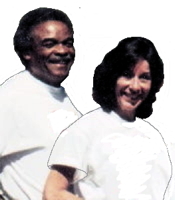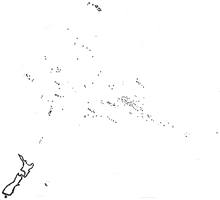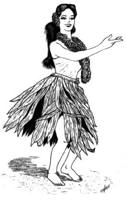
|
The Society of Folk Dance Historians (SFDH)
Polynesian History
[
Home |
About |
Encyclopedia | CLICK AN IMAGE TO ENLARGE |

|
 Polynesia consists of a group of islands scattered throughout the Western Pacific Ocean. Included among these are New Zealand, the Samoan Islands, the Tonga Islands, the Cook Islands, the Marquesas Islands, Easter Island, the Austral Islands, the Gambler Islands, the Fiji Islands, the Society Islands (best known of which are Tahiti, Moorea, and Raiatea), and the Hawaiʻian Islands.
Polynesia consists of a group of islands scattered throughout the Western Pacific Ocean. Included among these are New Zealand, the Samoan Islands, the Tonga Islands, the Cook Islands, the Marquesas Islands, Easter Island, the Austral Islands, the Gambler Islands, the Fiji Islands, the Society Islands (best known of which are Tahiti, Moorea, and Raiatea), and the Hawaiʻian Islands.
Cultural anthropologists have grouped these diverse islands together based on strong language similarities and parallels in social structure. All Polynesian languages have the same root, a branch of the Austronesian language family, and people from each of these island groups are able to communicate with each other.
There have been several theories of Polynesian origin proposed by scholars over the years. Most agree that the original settlers came from the Asia's South China coast sometime after 2000 BCE, probably in two separate waves.
There is, however, some disagreement about which island or island group was settled first and about the migration patterns that followed. One author hypothesized that the Samoan Islands (Western Polynesia) was settled first, followed by the Marquesas and the Society Islands, and finally by the outlying islands. Another surmises that the Marquesas Islands were the first to be settled around 300 CE, then the Hawaiʻian Islands and Easter Island somewhere between 700 and 1100 CE, and finally the Cook and Austral Islands and possibly New Zealand.
 Once settled, each of the islands underwent a period of cultural development. Social development followed definite hierarchical lines, with chiefs and their close kin at the top, followed by priests and craftsmen, commoners, and "slaves." Genealogical records were memorized and recited orally on many occasions to ensure that everyone knew their ancestral rights. Tribal kin grouped into villages under hereditary chiefs, who claimed their status as the eldest son of the eldest male of a given hereditary line (ancestrally "related" to one of the many gods). The very powerful, prestigious high chiefs were considered "sacred" and held the power of life and death over all others. Priests/craftsmen specialized in sacred crafts, temple ritual, oral tradition, and formula chants. They were frequently called upon to intervene for the villagers with lesser gods, spirits, and ancestors in matters regarding the affairs of daily human life. Commoners made up the bulk of the population and did most of the fishing, hunting, gathering of foodstuffs, and growing of crops. Slaves were generally captured during warfare, and they and their offspring formed the slave class. Though people were born to their social class and generally stayed there, exceptions abound in the legend and folklore of the islands.
Once settled, each of the islands underwent a period of cultural development. Social development followed definite hierarchical lines, with chiefs and their close kin at the top, followed by priests and craftsmen, commoners, and "slaves." Genealogical records were memorized and recited orally on many occasions to ensure that everyone knew their ancestral rights. Tribal kin grouped into villages under hereditary chiefs, who claimed their status as the eldest son of the eldest male of a given hereditary line (ancestrally "related" to one of the many gods). The very powerful, prestigious high chiefs were considered "sacred" and held the power of life and death over all others. Priests/craftsmen specialized in sacred crafts, temple ritual, oral tradition, and formula chants. They were frequently called upon to intervene for the villagers with lesser gods, spirits, and ancestors in matters regarding the affairs of daily human life. Commoners made up the bulk of the population and did most of the fishing, hunting, gathering of foodstuffs, and growing of crops. Slaves were generally captured during warfare, and they and their offspring formed the slave class. Though people were born to their social class and generally stayed there, exceptions abound in the legend and folklore of the islands.
Religion centered around numerous gods, both high and low. Generally, the higher the gods, the more remote they were from human activities. Cosmic deities served to represent "mother nature" in all her manifestations. Then there were patron gods, who served as benefactors to tribal activities and governed man's activities on land and sea. Family protectors were local gods, tribal ancestral spirits, cultural heroes, and spirits. These were appealed to on all common occasions and their omens heeded.
Gods both great and small were honored with music, dance, chanting, and other various rituals. Seasoned celebrations, too, were celebrated with dance and song. Everyone participated, everyone sang and danced. Professional performers were greatly respected for their role in religious ceremony, and sometimes even elevated to the rank of royalty.
In Tahiti, dance was a part of daily life. All festivities were marked by dancing, and it followed many a meal. It was used to commemorate and accompany almost all occasions, and arose spontaneously during travel and at various work projects. There were dances to accompany gift giving, dances of welcome, dances to celebrate political events, dances to show joy – dances for just about any occasion. Dance was part of the great rituals that brought the population together to mark the beginning of the harvest season, it's high point, and it's ending. Gifts were offered to the chiefs and the gods and special dances, of a clear religious nature, were organized during these times. There was an association of dancers, the "arioi," comprised of initiated members devoted to the cult of Oro, the Tahitian god of rain, fertility, song, and dance. Though dance was not a religious activity in itself (as well as chanting), it almost always accompanied religious ceremonies.
The coming of European missionaries in the 1800s marked the beginning of the end of Polynesian social and religious structure. "Codes" were established prohibiting "all songs, games, or wanton amusements (including dancing)." With the suppression of native religion came idol and temple destruction and the systematic suppression of dance and song associated with it. Suppression continued to a greater or lesser degree through the entire 19th century. Dancing only began to resurface in the beginning of the 20th century, though many dance forms were lost, and many have changed because of Western or other foreign influences.
DOCUMENT
- Polynesia, a region.
Printed in Folk Dance Scene, October 1995.
This page © 2018 by Ron Houston.
Please do not copy any part of this page without including this copyright notice.
Please do not copy small portions out of context.
Please do not copy large portions without permission from Ron Houston.